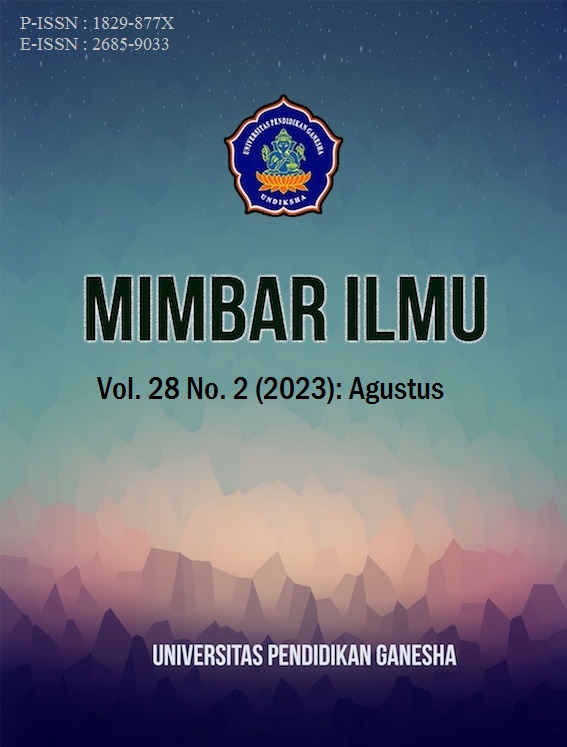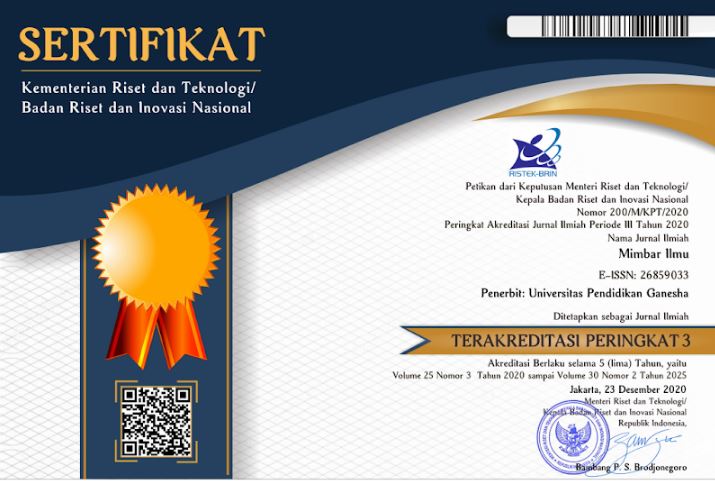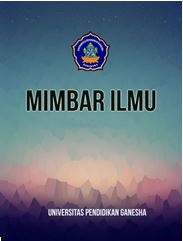Apology Strategy in Senior High School Students of North Aceh Dialect
DOI:
https://doi.org/10.23887/mi.v28i2.62294Keywords:
Strategy, Forgive, Dialect, High SchoolAbstract
An apology is an important expression of contact. The form of apology differs from the form of apology in different languages, circumstances, beliefs, ethnography, and so on. In certain situations, forgiveness is a form of accepting mistakes someone makes. This study examines the apology strategies used in the North Aceh dialect among high school students. This research is qualitative research with survey analysis. The subjects of this study were 40 students. The methods used to collect data are interviews, questionnaires, and surveys. The instrument used to collect data is a questionnaire. The technique used to analyze the data is descriptive qualitative analysis. Research has shown that, although direct and indirect reasons can lead to long discussions among the interlocutors, the communicative content can be observed through indirect reasons so that shared views and attitudes can be conveyed. Further analysis of the different statistics is suggested to look at the gaps in apology across ages. Further analysis of the different statistics is recommended to examine the gaps in the apology strategy of these two variables, age group, and gender.
References
Alahmad, T. H. M. (2020). Linguistic Politeness and Gender: Apology Strategies: A Sociolinguistic Research. International Journal of Linguistics, 12(1). https://doi.org/10.5296/ijl.v12i1.16484. DOI: https://doi.org/10.5296/ijl.v12i1.16484
Amdani, Y., & Krisna, L. A. (2019). Konsep Meminta Maaf Sebagai Hukuman Dalam Perkara Pidana. Jurnal Hukum IUS QUIA IUSTUM, 26(1). https://doi.org/10.20885/iustum.vol26.iss1.art4. DOI: https://doi.org/10.20885/iustum.vol26.iss1.art4
Andrade, M. S., Evans, N. W., & Hartshorn, K. J. (2014). Linguistic support for non-native English speakers: Higher education practices in the United States. Journal of Student Affairs Research and Practice, 51(2). https://doi.org/10.1515/jsarp-2014-0020. DOI: https://doi.org/10.1515/jsarp-2014-0020
Anshori, D. S. (2018). Tindak tutur ekspresif meminta maaf pada masyarakat Muslim melalui media sosial di hari raya. Lingua : Jurnal Ilmiah, 14(2). https://doi.org/10.15294/lingua.v14i2.15164.
Atmaja, A. N. I. (2014). Analisis Penggunaan Tindak Tutur Kata “Maaf” Bahasa Jepang. Chi’e: Jurnal Pendidikan Bahasa Jepang, 3(1). https://doi.org/10.15294/chie.v3i1.4306.
Aydına, B., Unverb, M. M., Alanc, B., & Sağlam, S. (2017). Journal Of Language And Linguistic Studies Combining the old and the new: Designing a curriculum based on the Taba model and the global scale of English. Journal of Language and Linguistic Studies, 13(1).
Barking, M., Mos, M., & Kamoen, N. (2022). Picture this! The effects of positivity bias, situation saliency, and verbal politeness in valence framing research. Journal of Pragmatics, 198. https://doi.org/10.1016/j.pragma.2022.06.008. DOI: https://doi.org/10.1016/j.pragma.2022.06.008
Broni, G., Velentzas, J., & Kartalis, N. (2013). Hobbes’s Meaning of Hostility & Politics of an Apology: The Double-edge of Organizational Legitimation. Strategic and Institutional Approaches in Crisis Communication. Procedia Economics and Finance, 5. https://doi.org/10.1016/S2212-5671(13)00016-6. DOI: https://doi.org/10.1016/S2212-5671(13)00016-6
Brown, P., & Levinson, S. C. (1987). Politeness. Some universals in language urage. Cambridge University Press. DOI: https://doi.org/10.1017/CBO9780511813085
Candrawati, M., Atmaja, H. T., & Khafid, M. (2019). Implementation of Discipline and Politeness Value and Their Relevancies Toward Social Attitudes of Elementary Students. Jurnal Profesi Keguruan, 5(1), 66–75.
Emilia, E., & Hamied, F. A. (2015). Systemic functional linguistic genre pedagogy (SFL GP) in a tertiary EFL writing context in Indonesia. TEFLIN Journal, 26(2). https://doi.org/10.15639/teflinjournal.v26i2/155-182. DOI: https://doi.org/10.15639/teflinjournal.v26i2/155-182
Gagné, N. O. (2010). Reexamining the notion of negative face in the Japanese Socio linguistic politeness of request. Language & Communication, 30(2). https://doi.org/10.1016/j.langcom.2009.12.001. DOI: https://doi.org/10.1016/j.langcom.2009.12.001
Georgiadou, E. (2023). How sorry are you? Intensified apologies and the mediating role of perceived remorse in corporate crisis communication. Public Relations Review, 94(4). https://doi.org/10.1016/j.pubrev.2023.102356. DOI: https://doi.org/10.1016/j.pubrev.2023.102356
Hendriks, B., Meurs, F. van, & Kakisina, B. (2023). The effects of L1 and L2 writers’ varying politeness modification in English emails on L1 and L2 readers. Journal of Pragmatics, 204. https://doi.org/10.1016/j.pragma.2022.12.006. DOI: https://doi.org/10.1016/j.pragma.2022.12.006
Korpela, R., Stevanovic, M., & Kurhila, S. (2023). Prosodic linking in apology sequences in Finnish elementary school mediations. Journal of Pragmatics, 214. https://doi.org/10.1016/j.pragma.2023.06.012. DOI: https://doi.org/10.2139/ssrn.4349240
Lailiyah, N. (2021). Tindak Tutur Ekspresif Meminta Maaf Terpidana Korupsi di Indonesia. Prasasti: Journal of Linguistic, 6(2). https://doi.org/10.20961/prasasti.v6i2.51038. DOI: https://doi.org/10.20961/prasasti.v6i2.51038
Li, Y.-N., Li, Y., Chen, H. (Allan), & Wei, J. (2023). How verbal and non-verbal cues in a CEO apology for a corporate crisis affect a firm’s social disapproval. Journal of Business Research, 163. https://doi.org/10.1016/j.jbusres.2023.114084. DOI: https://doi.org/10.1016/j.jbusres.2023.114084
MacLachlan, A. (2013). Gender and Public Apology. Transitional Justice Review, 1. DOI: https://doi.org/10.5206/tjr.2013.1.2.6
Mariasari, S. (2018). Strategi Tindak Tutur Ekspresif Meminta Maaf Oleh Penutur Asli Bahasa Jawa Dialek Banyumas. Prosiding Seminas LPPM UNSOED, 8(1).
Maruti, E. S. (2016). Tindak Tutur Meminta Maaf Secara Samudana Terselubung Dalam Bahasa Jawa. Ranah: Jurnal Kajian Bahasa, 5(1). https://doi.org/10.26499/rnh.v5i1.38. DOI: https://doi.org/10.26499/rnh.v5i1.38
Mukaromah, D. (2015). Apology: A Strategy To Recognize Speakers’ Behaviour (The Analysis Of Apology Found In “The Sound Of Music” Play). Transformatika: Jurnal Bahasa, Sastra, dan Pengajarannya, 11(2). https://doi.org/10.31002/transformatika.v11i2.218.
Ridealgh, K., & Gómez, L. U. (2020). Potestas and the language of power: Conceptualising an approach to Power and Discernment politeness in ancient languages. Journal of Pragmatics, 170. https://doi.org/10.1016/j.pragma.2020.09.011. DOI: https://doi.org/10.1016/j.pragma.2020.09.011
Suwendra, I. W. (2018). Metodologi Penelitian Kualitatif dalam Ilmu Sosial, Pendidikan, Kebudayaan, dan Keagamaan. In NilaCakra Publishing House, Bandung.
Trosborg. A. (1995). Interlanguage pragmatics: Requests, complaints and apologies. Oxford University Press. DOI: https://doi.org/10.1515/9783110885286
Usó-Juan, E., & Martínez-Flor, A. (2015). Assessing EFL Learners’ Performance of the Conventional Expressions of Complaining and Apologising. Procedia - Social and Behavioral Sciences, 173. https://doi.org/10.1016/j.sbspro.2015.02.030. DOI: https://doi.org/10.1016/j.sbspro.2015.02.030
Wang, K., Zhou, L., & Zhang, S. (2023). Explicit and implicit (im)politeness: A corpus-based study of the Chinese formulaic expression “Nikezhen+X”. Lingua, 291. https://doi.org/10.1016/j.lingua.2023.103560. DOI: https://doi.org/10.1016/j.lingua.2023.103560
Wouk, F. (2006). The language of apologizing in Lombok, Indonesia. Journal of Pragmatics, 38(9). https://doi.org/10.1016/j.pragma.2005.09.011. DOI: https://doi.org/10.1016/j.pragma.2005.09.011
Downloads
Published
How to Cite
Issue
Section
License
Copyright (c) 2023 Isda Pramuniati, Mahriyuni, Marice

This work is licensed under a Creative Commons Attribution-ShareAlike 4.0 International License.
This work is licensed under a Creative Commons Attribution-ShareAlike 4.0 International License.
Authors who publish with this journal agree to the following terms:
- Authors retain copyright and grant the journal right of first publication with the work simultaneously licensed under a Creative Commons Attribution License that allows others to share the work with an acknowledgment of the work's authorship and initial publication in this journal.
- Authors are able to enter into separate, additional contractual arrangements for the non-exclusive distribution of the journal's published version of the work (e.g., post it to an institutional repository or publish it in a book), with an acknowledgment of its initial publication in this journal.
- Authors are permitted and encouraged to post their work online (e.g., in institutional repositories or on their website) prior to and during the submission process, as it can lead to productive exchanges, as well as earlier and greater citation of published work.









